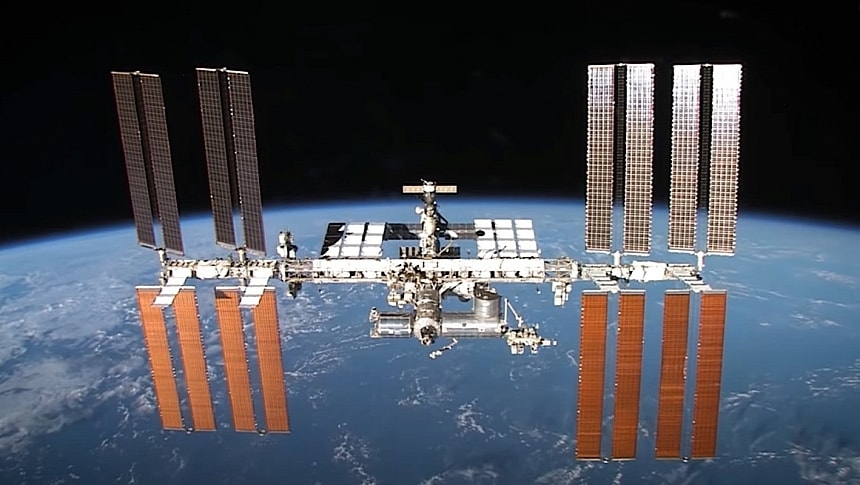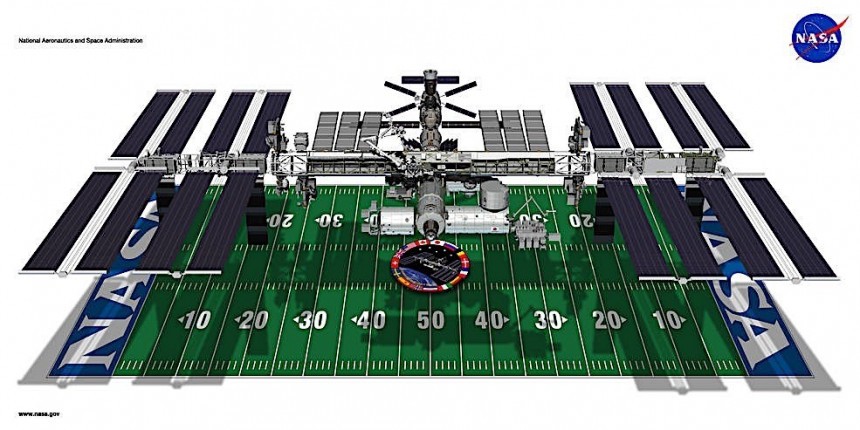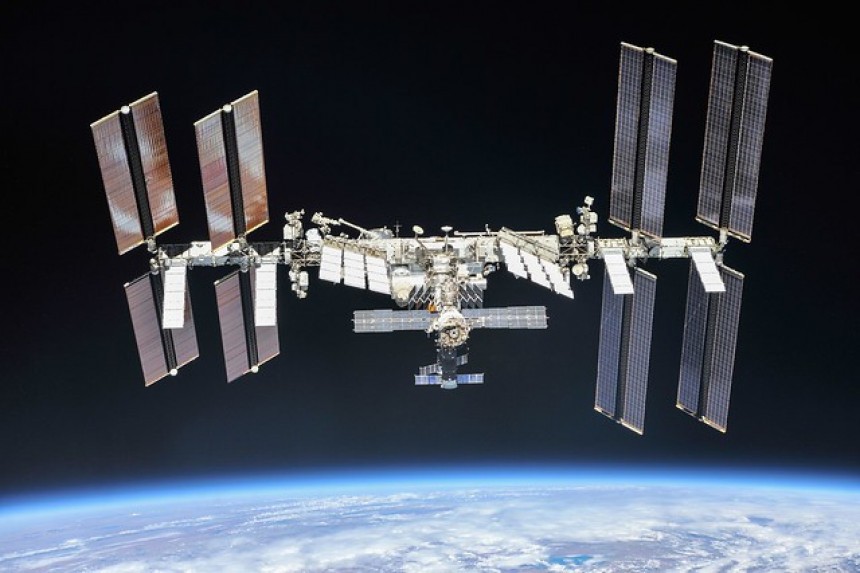It's not long now, folks, until the most important and successful space habitat the human species has ever made will crash and burn into Earth's atmosphere. In 2030, the International Space Station (ISS) will intentionally be brought down, as it is getting too old to be kept operational. Tasked with this gargantuan task are several space agencies, but also Elon Musk's SpaceX.
The ISS started being built in 1998, when the first component was launched. It was put together in successive missions on an orbit 408 km (253 miles) away from the planet's surface, becoming the third brightest object in the night sky.
357 feet end-to-end and offering a habitable volume of 13,696 cubic feet (388 cubic meters), the station, with its modules, the integrated truss structure, and the solar panels, has become one of the most recognizable objects in space exploration.
During its time in orbit the place was for brief periods of time home to over 270 people from over 20 countries, flying up there with the backing of the world's largest space agencies: American NASA, Canadian CSA, European ESA, Japanese JAXA, and Russian Roscosmos.
The astronauts who went up there performed about 3,300 science experiments in the decades the orbital laboratory has been up and running.
All of the above-mentioned entities are now preparing for the end of the station's life. Because of the severe dynamic and thermal stresses it was subjected to over the years, the ISS will soon reach a state that will no longer be safe to operate, but also impossible to repair.
The demise of humanity's home in the sky is something that was a long time coming, despite a number of scenarios, including in-orbit disassembly and moving it to a graveyard orbit, being considered. The termination will unfold in a manner so spectacular it will probably be an event to be discussed for years to come.
The deorbiting of the ISS will be a combination between the station's natural orbital decay and the intentional lowering of the orbit until Earth's gravity takes over and pulls the habitat into the atmosphere.
Weighing about 450 tons (992,000 pounds), the ISS' rather low orbit means it is constantly pulled in by the planet below. It managed to keep a constant distance all these years by performing re-boosts every two years or so.
No re-boost will be performed at the end of the decade, though, meaning the station will be allowed to fall from the sky. But since doing things solely in this manner would potentially put humans here on Earth at risk, the biggest operator of the place, NASA, will also use something it now calls the U.S. Deorbit Vehicle to give the station some sort of means of propulsion and steer it clear of populated areas.
NASA has been looking for such a vehicle for a while now. It even considered using three Russian Progress spacecraft, but for reasons that were not disclosed the plan was scrapped.
The agency finally seems to have found someone to build the deorbiter. It announced at the start of the week that SpaceX has been tasked with this mission, and that the private company might receive as much as $843 million for its contribution.
The mission is perhaps one of the riskiest SpaceX has ever embarked on. Sure, building the spacecraft and the deorbit maneuver themselves might not seem that complicated for someone who knows what they are doing, but you do have to consider the fact that, if anything goes wrong, a lot of people here on the ground could be at risk.
Aside from giving the ISS a nudge as it falls from orbit, the Deorbit Vehicle will also have to perform a re-entry maneuver that's meant to point the station at a place on Earth far enough from any human to prevent disaster - a place such as the Pacific Point Nemo, a region of the ocean 2,688 km (1,670 miles) away from the nearest land mass.
The re-entry should be as risky as it will be spectacular to watch. NASA expects the station's solar array and radiator will be the first ones to go up in flames. The modules should break apart after that and will start to disintegrate, and finally the truss should cease to exist.
It's unclear how much of the ISS will actually make it all the way down to the surface, but chances are whatever makes it here will sink to the bottom of the ocean.
Now that it got this major contract, SpaceX will start working on the deorbit vehicle, a piece of machinery we know absolutely nothing about at this point. When ready, the spacecraft will enter NASA's ownership. It will also be NASA that will be operating the craft during the ISS deorbit, and expectations are SpaceX's design will be destroyed as well during re-entry, as it will still be attached to the station.
It's unclear how long it will take SpaceX to come up with a design, but the company has to be fast on its feet. Russia will pull out from the ISS in 2028, and the rest of the nations will do the same in 2030. The ISS must be brought down in a controlled manner by 2032, otherwise chances are it will head our way on its own accord.
357 feet end-to-end and offering a habitable volume of 13,696 cubic feet (388 cubic meters), the station, with its modules, the integrated truss structure, and the solar panels, has become one of the most recognizable objects in space exploration.
During its time in orbit the place was for brief periods of time home to over 270 people from over 20 countries, flying up there with the backing of the world's largest space agencies: American NASA, Canadian CSA, European ESA, Japanese JAXA, and Russian Roscosmos.
The astronauts who went up there performed about 3,300 science experiments in the decades the orbital laboratory has been up and running.
All of the above-mentioned entities are now preparing for the end of the station's life. Because of the severe dynamic and thermal stresses it was subjected to over the years, the ISS will soon reach a state that will no longer be safe to operate, but also impossible to repair.
The deorbiting of the ISS will be a combination between the station's natural orbital decay and the intentional lowering of the orbit until Earth's gravity takes over and pulls the habitat into the atmosphere.
Weighing about 450 tons (992,000 pounds), the ISS' rather low orbit means it is constantly pulled in by the planet below. It managed to keep a constant distance all these years by performing re-boosts every two years or so.
No re-boost will be performed at the end of the decade, though, meaning the station will be allowed to fall from the sky. But since doing things solely in this manner would potentially put humans here on Earth at risk, the biggest operator of the place, NASA, will also use something it now calls the U.S. Deorbit Vehicle to give the station some sort of means of propulsion and steer it clear of populated areas.
NASA has been looking for such a vehicle for a while now. It even considered using three Russian Progress spacecraft, but for reasons that were not disclosed the plan was scrapped.
The agency finally seems to have found someone to build the deorbiter. It announced at the start of the week that SpaceX has been tasked with this mission, and that the private company might receive as much as $843 million for its contribution.
Aside from giving the ISS a nudge as it falls from orbit, the Deorbit Vehicle will also have to perform a re-entry maneuver that's meant to point the station at a place on Earth far enough from any human to prevent disaster - a place such as the Pacific Point Nemo, a region of the ocean 2,688 km (1,670 miles) away from the nearest land mass.
The re-entry should be as risky as it will be spectacular to watch. NASA expects the station's solar array and radiator will be the first ones to go up in flames. The modules should break apart after that and will start to disintegrate, and finally the truss should cease to exist.
It's unclear how much of the ISS will actually make it all the way down to the surface, but chances are whatever makes it here will sink to the bottom of the ocean.
Now that it got this major contract, SpaceX will start working on the deorbit vehicle, a piece of machinery we know absolutely nothing about at this point. When ready, the spacecraft will enter NASA's ownership. It will also be NASA that will be operating the craft during the ISS deorbit, and expectations are SpaceX's design will be destroyed as well during re-entry, as it will still be attached to the station.
It's unclear how long it will take SpaceX to come up with a design, but the company has to be fast on its feet. Russia will pull out from the ISS in 2028, and the rest of the nations will do the same in 2030. The ISS must be brought down in a controlled manner by 2032, otherwise chances are it will head our way on its own accord.














